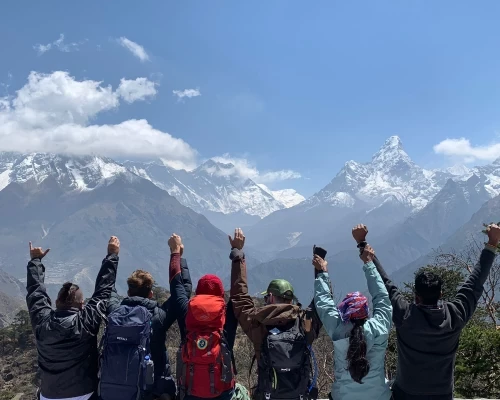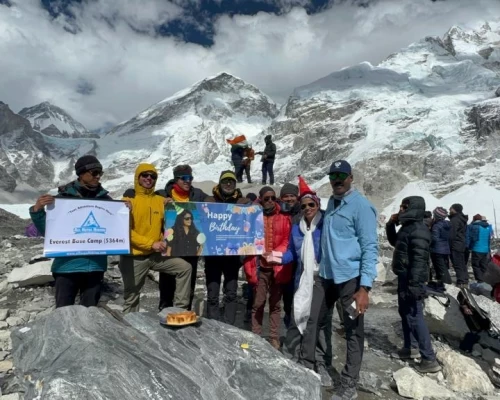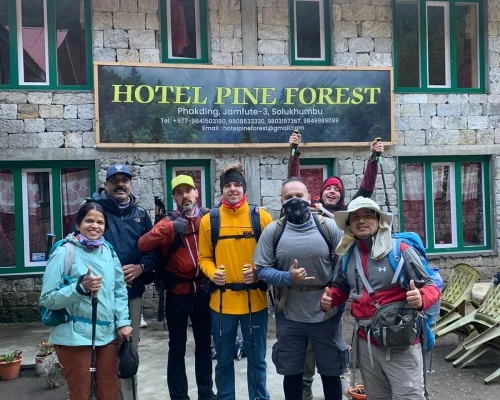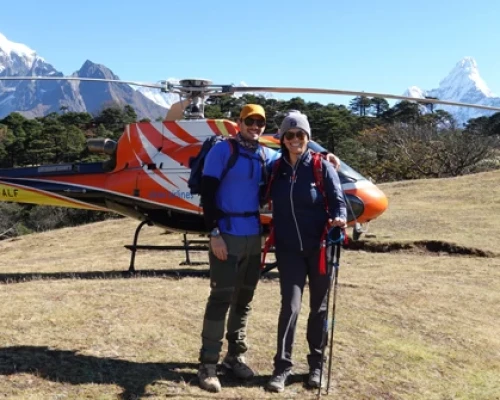All Nepal Hiking offers an exhilarating 9-day Everest Base Camp trek with helicopter return, perfectly designed for travelers who want to experience the stunning beauty and rich culture of the Everest region while optimizing their time and comfort. This hybrid itinerary combines immersive trekking through the heart of the Himalayas with the convenience of a scenic helicopter flight from Gorak Shep back to Kathmandu, providing the best of both worlds.
During the trek, you will explore the bustling Namche Bazaar, known for its vibrant Sherpa culture and lively mountain markets. Along the trail, you will visit ancient Buddhist monasteries, revered chortens (stupas), intricately carved Mani walls, and historic Buddhist rock paintings that offer a deep insight into the spiritual heritage of the region. Adventurers will also experience crossing thrilling suspension bridges over glacial rivers, all set against breathtaking panoramic views of Everest, Lhotse, Nuptse, and Ama Dablam.
This fast-paced trek involves moderate to strenuous hiking, with daily trekking times of 5 to 8 hours, ascending to Everest Base Camp at 5,364 meters (17,598 feet) and Kala Patthar viewpoint at 5,645 meters (18,533 feet). The itinerary includes planned acclimatization days to help prevent Acute Mountain Sickness (AMS) and ensure trekkers’ safety and enjoyment.
After completing the trek on foot, participants board a helicopter at Gorak Shep for a spectacular aerial return to Kathmandu, offering unique views of the Everest region’s rugged landscapes, glaciers, and towering peaks, while significantly reducing travel time.
This 9-day Everest Base Camp trek with helicopter return is ideal for time-conscious trekkers who want the full Everest experience without the typical 12-14 day commitment, adventure seekers looking to combine trekking with stunning aerial vistas, photographers aiming to capture the region’s iconic landscapes efficiently, and anyone seeking a safe, guided trekking experience supported by expert guides trained in altitude sickness protocols.
Choosing this package means enjoying a comprehensive trekking adventure that includes cultural highlights, natural wonders, and iconic Himalayan landmarks, all within a time-efficient itinerary supported by professional trekking services. It offers unforgettable opportunities to witness Everest’s majestic sunrises and sunsets from multiple viewpoints, including Kala Patthar, making it an exceptional choice for those eager to immerse themselves in the Everest region.
Best Time for Everest Base Camp Trek with Helicopter Return
Knowing the best times for an expedition is crucial for planning, especially for challenging treks like Everest Base Camp in Nepal. Spring and Autumn are considered prime seasons for these journeys due to favorable weather conditions.
Autumn (September-November):
Autumn follows the Monsoon season, offering clear skies and stunning views. The rain cleanses the landscapes, providing a fresh perspective of the Mahalangur Himalayas. With warm days, ample sunlight, and great visibility, this season is ideal for trekking. Temperatures range from 15 to 24ºC in higher elevations. While the first few weeks might still have some rain, Autumn's stable and calm weather lasts from mid-September to late November. It's a popular time, so expect other trekkers on the trail.
Spring (March-May):
Spring, marked by pleasant temperatures, stable weather, and blossoming landscapes, is another excellent time for Everest Base Camp treks. Temperatures range from 16 to 23ºC in higher areas. Clear skies, lush surroundings, and stunning mountains create a breathtaking trekking experience. Spring is busy, drawing numerous trekkers worldwide. Although not as crowded as in Autumn, the trails are still quite populated. Visibility is enhanced due to sunny days. Choose April for the best conditions for Everest Base Camp Helicopter Return.
Summer (June-August):
Summer brings rain and cloudy weather to Nepal. From June to August, rainfall is common, affecting visibility and making trails slippery. Trekking during this time is challenging due to mud, leeches, and mosquitoes. The trails are less crowded, offering a more peaceful experience. However, trekking in Summer is not ideal for Everest Base Camp Helicopter Return due to unstable weather conditions. Late August is relatively better, with lower precipitation levels.
Winter (December-February):
Winter, lasting from December to February, is cold and less frequented by trekkers. The daytime temperature ranges from 9 to 12ºC, and higher elevations experience freezing temperatures. The colder conditions present challenges, but some trekkers undertake low-altitude hikes. Snowfall is possible in higher areas, making higher altitude treks more difficult. While Winter offers snow-covered views and a fresh ambiance, operating helicopter tours in snowy Himalayan regions can be risky.
Remember that each season has its advantages and challenges, so plan accordingly based on your preferences and priorities for your Everest Base Camp expedition.
What to expect during a normal trekking day?- Everest Base Camp Trek 9 Days
The difficulty of the 9-day Everest Base Camp Trek primarily stems from the altitude rather than steep ascents or descents. The trail to Everest Base Camp and Kalapathar is considered moderately challenging. The itinerary for the Everest Helicopter Trek includes a direct return from Gorakshep to Kathmandu after visiting Everest Base Camp (5364 m) and Kalapathar (5545 m), significantly reducing the walking time to 4 days due to the helicopter ride.
Accommodation during the trek is in teahouses or lodges, offering a range of comfort levels from basic to more luxurious options. Meals are available from a varied menu with both local and Western dishes. While there are upscale accommodations along the trail, especially before Tengboche, beyond this point, trekkers typically share rooms or stay in standard lodges. If you're interested in luxury trekking in the Everest region, it's advisable to consult with our travel planners in advance.
The 9-day Everest Base Camp Trek presents a journey starting at Kathmandu (1300 m) and reaching up to Kalapathar (5545 m). Over these 9 days, trekkers encounter a remarkable variety of landscapes and vegetation. The lower portions of the trail are covered in deciduous temperate forests, while the middle section features alpine vegetation, and the highest parts exhibit tundra vegetation. The route encompasses a diverse range of experiences, from cascading hills and riverbanks to moraines and glaciers.
Throughout the Everest Base Camp Trek 9 Days, you'll be treated to views of renowned mountains, including:
- Everest (8,849 m)
- Makalu (8,463 m)
- Lhotse (8,516 m)
- Cho Oyu (8,188 m)
- AmaDablam (6,812 m)
- Pumori (7,161 m)
- Cholatse (6,440 m)
- Thamserku (6,608 m)
- Island Peak (6,160 m)
- Nuptse (7,861 m)
This trek offers a comprehensive experience of the Khumbu region. Additionally, the inclusion of a helicopter tour from Gorakshep to Kathmandu elevates the journey's luxury factor. Observing the Everest Base Camp trail and the Gokyo Lake Valley from a helicopter provides breathtaking visuals. This trip combines the rich narratives of both walking the trail and soaring above the majestic hills, creating a truly exceptional adventure in Nepal.
Everest Base Camp Trek With Helicopter Return to Avoid Altitude Sickness
Altitude sickness, scientifically termed acute mountain sickness (AMS), is a common concern among those embarking on the Everest Base Camp trek with a helicopter return. Rapid gains in altitude necessitate proper acclimatization to prevent altitude sickness (AMS).
AMS symptoms encompass headaches, fatigue, dizziness, and nausea. If unaddressed, it can escalate, leading to high-altitude pulmonary edema (HAPE) and high-altitude cerebral edema (HACE).
Mitigating the risk of AMS involves gradual ascents, adequate hydration, and refraining from alcohol and tobacco. Carrying medications like acetazolamide is advisable, alongside a preparedness plan for managing AMS indicators. With thoughtful planning and AMS awareness, your journey to Everest Base Camp can be both secure and enjoyable.
Packing List for Everest Base Camp Trek with Helicopter Return
2. Backpack: Choose a high-quality backpack with sufficient space for essentials, water, food, and personal items.
3. Hiking Boots: Sturdy boots with good grip and ankle support for varied terrain.
4. Sleeping Bag: A warm, comfortable sleeping bag suitable for cold altitudes.
5. Tent: A durable tent designed for high-altitude conditions, able to withstand wind and snow.
6. Headlamp: Essential for navigating in low-light conditions.
7. Water Bottles: Carry at least two bottles to stay hydrated.
8. Sunscreen and Sunglasses: Protection against UV rays at higher altitudes.
9. First Aid Kit: Basic supplies like pain relief, bandages, antiseptic wipes, etc.
10. Trekking Poles: Helpful for stability on challenging trails.
11. Portable Charger: Keep your devices powered during the trek.
12. Passport (valid for 6 months), travel insurance with helicopter evacuation coverage, passport-sized photos, flight itinerary, doctor's recommendation if needed, completed medical form for altitude sickness, proof of payment, permits (TIMS card, Sagarmatha National Park), emergency contact info, valid Nepal visa, and cash for expenses and emergencies.
Tailor your packing list based on individual preferences and needs, ensuring you're well-prepared for a safe and enjoyable Everest Base Camp trek with helicopter return.







 based on 2 reviews
based on 2 reviews
.webp)